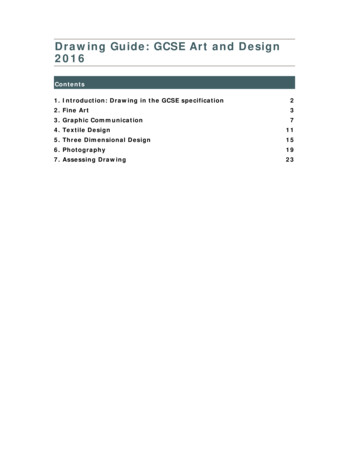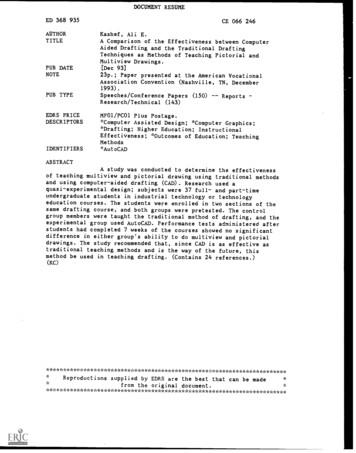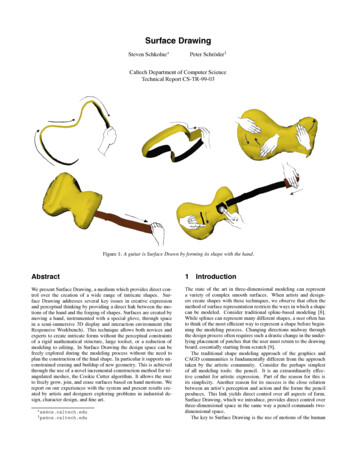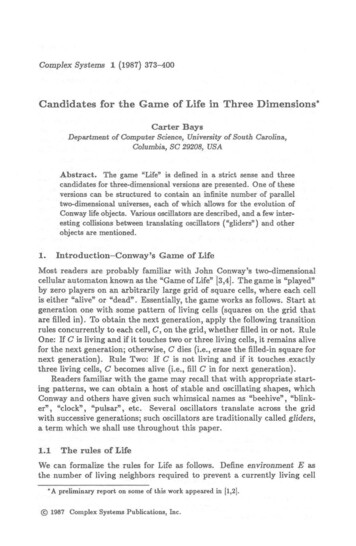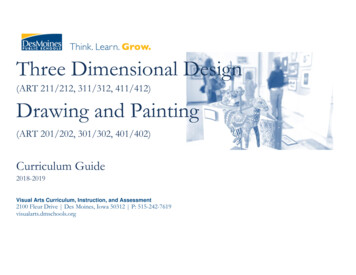
Transcription
Three Dimensional Design(ART 211/212, 311/312, 411/412)Drawing and Painting(ART 201/202, 301/302, 401/402)Curriculum Guide2018-2019Visual Arts Curriculum, Instruction, and Assessment2100 Fleur Drive Des Moines, Iowa 50312 P: 515-242-7619visualarts.dmschools.org
3D Design, Drawing & Painting (ART 211/212, 311/312, 411/412) (ART 201/202, 301/302, 401/402)SuperintendentThomas Ahart, Ed.DExecutive Director of Secondary Teaching & LearningNoelle TichyDirector of Secondary Teaching & LearningSarah DoughertyVisual Arts Curriculum CoordinatorBenjamin HeinenSecondary Curriculum Lead Team Editors – Middle SchoolJessica Wenck, Weeks Middle SchoolKara Dare, Cowles Montessori SchoolMargo Greenberg, Meredith Middles SchoolLisa Hesse, Hoyt Middle SchoolSecondary Curriculum Lead Team Editors – High SchoolAmy Palmer, North High SchoolHeather Worthington, Lincoln High School2
3D Design, Drawing & Painting (ART 211/212, 311/312, 411/412) (ART 201/202, 301/302, 401/402)ForewordCurriculum in this document is based on the National Core ArtsStandards published in the spring of 2014. It has been developedby visual art educators and curriculum specialists in the DesMoines Public Schools. The objectives in this curriculum guideare the minimum requirements in the visual arts that set rigorous,relevant, clear, and measurable learning targets and expectationsfor what teachers should teach and students should learn.Schools and educators are continuously encouraged to go beyondthese targets to better serve the needs of all students in the visualarts.Definition of the Visual ArtsVisual arts include the traditional fine arts such as drawing,painting, printmaking, photography, and sculpture; media artsincluding film, graphic communications, animation, and emergingtechnologies; architectural, environmental, and industrial artssuch as urban, interior, product, and landscape design; folk arts;and works of art such as ceramics, fibers, jewelry, works in wood,paper, and other materials. –National Art Education Association3
3D Design, Drawing & Painting (ART 211/212, 311/312, 411/412) (ART 201/202, 301/302, 401/402)Table of ContentsHow to use this document .4DMPS Philosophy & Learning Objectives . .5-6Document Structures . .7Yearlong Learning Goals . .9-10Topics . .11-16Creating . .11 & 14Connecting . .12 & 15Responding . .13 & 16Common Vocabulary .17Elements of Art . 18Principles of Design .19Four-Step Critical Analysis Process .22How to use this document:This curriculum guide is not A lock-step instructional guide detailing exactly when and how you teach.Meant to restrict your creativity as a teacher.A ceiling of what your students can learn, nor a set of unattainable goals.4
3D Design, Drawing & Painting (ART 211/212, 311/312, 411/412) (ART 201/202, 301/302, 401/402)Instead, the curriculum guide is meant to be a common vision for student learning and a set ofstandards by which to measure and report student progress and provide meaningful feedback.The curriculum guide outlines which learning goals are most essential for student learning; it is our district’s guaranteed and viablecurriculum. The expectation is that every student in our district, regardless of school or classroom, will know and understand theselearning goals. As the classroom teacher, you should use the curriculum guide to help you to decide how to scaffold up to thelearning goals, and extend your students’ learning beyond them.The curriculum guide is a planning tool; assessed clusters and topics are provided, but as the instructional leader of yourclassroom, you determine the scope and sequence in which you will introduce the prioritized learning goals. You areencouraged to create your own sub-units of study within each cluster using the topics as a starting point. Within this document youwill find a foundational structure for planning instruction in the visual arts which can be supplemented with unlimited materials fromany number of sources, including but not limited to district texts and prints.Please consider this guide a living and dynamic document, subject to change and a part of a continuous feedback loop.Des Moines Public Schools Educational PhilosophyVisionBecoming the model for urban education in the United States.Mission StatementThe Des Moines Public Schools Exist So That Graduates Possess the Knowledge, Skills and Abilities to Be Successful at the Next Stage of Their Lives.5
3D Design, Drawing & Painting (ART 211/212, 311/312, 411/412) (ART 201/202, 301/302, 401/402)Student ExpectationsStudents demonstrate proficiency and understanding of a rigorous core curriculum: They demonstrate proficiency in reading, writing, speaking and listeningThey demonstrate proficiency in mathematics, including algebra and geometryThey demonstrate financial and economic literacyThey demonstrate an understanding of the value of fine and performing arts in societyThey demonstrate proficiency in technological and information literacyThey demonstrate proficiency in science, including life, earth and physical scienceStudents possess the knowledge and skills to be self-directed and autonomous: TheyTheyTheyTheydemonstrate critical thinking and problem solving skillsexercise sound reasoning in making complex choicesexhibit creative, innovative and entrepreneurial thinkingunderstand the attributes of physical and mental well-beingStudents have world awareness: TheyTheyTheyThey learn from and work with individuals representing diverse cultures and religions in a spirit of mutual respect in school, work and communityunderstand the rights and obligations of citizenship at local, state, national, and global levelsare actively engaged in community lifewill be exposed to languages and cultures of the worldDes Moines Public Schools K-12 Student Learning Objectives in the Visual Artso Students can communicate at a foundational level in the visual arts. This includes knowledge and skills in the use of basic vocabularies, materials, tools,techniques, and intellectual methods of the discipline.o Students can communicate proficiently in at least one art form, including the ability to define and solve artistic problems with insight, reason, andtechnical proficiency.o Students can develop foundational evaluations and analyses of works of art from structural, historical, and cultural perspectives.6
3D Design, Drawing & Painting (ART 211/212, 311/312, 411/412) (ART 201/202, 301/302, 401/402)o Students can develop an informed acquaintance with exemplary works of art from a variety of cultures and historical periods, and a basic understandingof historical development in the arts disciplines, across the arts as a whole, and within cultures.Effective Components of an Educational Studio Programo Demonstrations of artistic techniques and uses of mediao Opportunities for practice, experimentation, and refinement based on effective feedbacko Support for divergent thinking and multiple learning outcomeso A rich and robust variety of visual referenceso A variety of critique and response formatso Introductions to and expectations for use of appropriate art vocabularyo Connections among artists, careers, and art in everyday life and communitieso An organizational system for storage and disbursement of materials and toolso Clear and maintained expectations for art room safety, cleaning, and classroom procedureso Integrations and connections with other content areaso Displays of various student works within the school and the communityDocument StructuresLearning goals for all curricular areas are organized by overarching concepts called topics. Within those topics live a learning goal. All learning goals for thevisual arts are guided by the 2014 National Visual Arts Standards and assessed on the provided reporting scales. The outline below serves to define thevarious elements of the curriculum structure. Learning Topic – The Overarching ConceptooDefinition of the topic.National Standards alignments – those most closely related to the overarching concept. Anchor Standard: Anchor standards define the expectations for students entering college and careers, and provide the foundation for the K-12 visual arts standards. Enduring Understanding: Statements summarizing important ideas and core processes that are central to visual arts and have lasting value beyond the classroom. Theysynthesize what students should understand—not just know or do—as a result of studying visual arts. Essential Questions: Organizing questions to set the focus for lessons or units. They are the initiators of creative and critical thinking.7
3D Design, Drawing & Painting (ART 211/212, 311/312, 411/412) (ART 201/202, 301/302, 401/402)Evidence of student learning is assessed on a four-point scale, common throughout the district. Scales are designed to measure each learning topic. Thegeneralized scale, with student-friendly language included, is below.SCALESCORE43210/MACADEMIC DESCRIPTORSTUDENT-FRIENDLY DESCRIPTORExceeding StandardI have demonstrated deep understandingthat goes beyond the learning goalMeeting StandardI have met the learning goalDeveloping Toward StandardInsufficient ProgressNo evidence of student understanding in submitted work ORMissing – student has not submitted evidenceI have the foundational skills and knowledgefor the learning goal and I am almost thereThe evidence I have submitted shows I have along way to go to reach the learning goalI have not submitted evidence of learning for the learning goal*For more information on district assessment and grading practices, please refer to the Grading Practices website l8
3D Design, Drawing & Painting (ART 211/212, 311/312, 411/412) (ART 201/202, 301/302, 401/402)Topic3D Design, Drawing & Painting II (ART 211/212) (ART 201/202) Learning Goals123InsufficientDeveloping Toward StandardMeeting StandardProgressCreatingStudent’sperformance reflectsinsufficient progresstowardsfoundational skillsand knowledge.ConnectingStudent’sperformance reflectsinsufficient progresstowardsfoundational skillsand knowledge.RespondingStudent’sperformance reflectsinsufficient progresstowardsfoundational skillsand knowledge. Generate and conceptualize artisticideas and work.o Use multiple approaches tobegin creative endeavors.(VA:Cr1.1.Ia)o Formulate an artisticinvestigation of art or designbased on chosen criteria.(VA:Cr1.2.Ia adapted) Relate artistic ideas and works withsocietal, cultural and historicalcontext to deepen understanding.o Investigate how culture,traditions, and historyinfluence personal responsesto art. (VA:Cn11.1.IIa) Interpret intent and meaning inartistic work. Analyze an artwork or collectionof works, based upon givencriteria and relevant or sufficientevidence found in the work andits various contexts. VA: Re8.1.IIa(adapted)Use Elements and Principles of DesignIdentify and Describe the Elements andPrinciples of Design in Original Artworksand the Artworks of OthersUse 4 Step Critical AnalysisUse Elements and Principles of DesignIdentify and Describe the Elements andPrinciples of Design in Original Artworksand the Artworks of OthersUse 4 Step Critical AnalysisUse Elements and Principles of DesignIdentify and Describe the Elements andPrinciples of Design in Original Artworksand the Artworks of OthersUse 4 Step Critical Analysis4ExceedingStandardIn addition to score3.0 performance,students demonstratein-depth inferencesand applications thatgo beyond thelearning target.In addition to score3.0 performance,students demonstratein-depth inferencesand applications thatgo beyond thelearning target.In addition to score3.0 performance,students demonstratein-depth inferencesand applications thatgo beyond thelearning target.9
3D Design, Drawing & Painting (ART 211/212, 311/312, 411/412) (ART 201/202, 301/302, 401/402)3D Design III-IV, Drawing & Painting III-IV (ART 311/312, 411/412) (ART 301/302, 401/402) Learning ientProgressStudent’s performancereflects insufficientprogress towardsfoundational skills andknowledge.Developing Toward Standard Student’s performancereflects insufficientprogress towardsfoundational skills andknowledge. Student’s performancereflects insufficientprogress towardsfoundational skills andknowledge. Use Elements and Principles of DesignIdentify and Describe the Elements andPrinciples of Design in Original Artworksand the Artworks of OthersUse 4 Step Critical AnalysisUse Elements and Principles of DesignIdentify and Describe the Elements andPrinciples of Design in Original Artworksand the Artworks of OthersUse 4 Step Critical AnalysisUse Elements and Principles of DesignIdentify and Describe the Elements andPrinciples of Design in Original Artworksand the Artworks of OthersUse 4 Step Critical AnalysisMeeting StandardIII: Organize and develop artistic ideas and work. Through experimentation, practice, andpersistence, demonstrate acquisition of skillsand knowledge in a chosen art form. (VA:Cr2.1.IIa)Exceeding StandardIn addition to score 3.0performance, studentsdemonstrate in-depthinferences andapplications that gobeyond the learningtarget.IV: Organize and develop artistic ideas and work. Experiment, plan, and make multiple worksof art and design that explore a personallymeaningful theme, idea, or concept. (VA:Cr2.1.IIIa)III: Synthesize and relate knowledge and personalexperiences to make art. Utilize inquiry methods of observation, research,and experimentation to explore unfamiliar subjectsthrough art-making. (VA: Cn10.1.IIa)IV: Relate artistic ideas and works with societal,cultural, and historical context to deepenunderstanding. Compare uses of art in a variety of societal,cultural, and historical contexts and makeconnections to uses of art in contemporary andlocal contexts.(VA: Cn11.1.lla)In addition to score 3.0performance, studentsdemonstrate in-depthinferences andapplications that gobeyond the learningtarget.III& IV. Interpret intent and meaning in artisticwork. Analyze differing interpretations of anartwork or collection of works in order toselect and defend a plausible critical analysis.(VA:Re8.1.IIIa)In addition to score 3.0performance, studentsdemonstrate in-depthinferences andapplications that gobeyond the learningtarget.10
3D Design, Drawing & Painting (ART 211/212, 311/312, 411/412) (ART 201/202, 301/302, 401/402)Intro 2D-3D: CREATING4321In addition to scoring a 3.0, the student demonstrates in-depthinferences and applications that go beyond the learning goal. Organize and develop artistic ideas and work. Through experimentation, practice and persistence,demonstrate acquisition of skills and knowledge in achosen art form. (VA: Cr2.1.IIa) Refine and complete artistic work. Engage in constructive critique with peers, then reflecton, re-engage, revise, and/or refine works of art anddesign in response to personal artistic vision as it pertainsto visual art criteria. (VA:Cr3.1.IIa) Use Elements and Principles of Design Identify and Describe the Elements and Principles ofDesign in Original Artworks and the Artworks ofOthersStudent’s performance reflects insufficient progress towards foundational skillsand knowledge.Enduring Understandings:Artists and designers experiment with forms, structures,materials, concepts, media, and art-making approaches.Artist and designers develop excellence through practiceand constructive critique, reflecting on, revising, andrefining work over time.Essential Questions:How do artists work? How do artists and designersdetermine whether a particular direction in their workis effective? How do artists and designers learn fromtrial and error?What role does persistence play in revising, refining, anddeveloping work? How do artists grow and becomeaccomplished in art forms? How does collaborativelyreflecting on a work help us experience it morecompletely?Cognitive Complexity of LearningGoals:A. ComprehensionB. Knowledge Utilization11
3D Design, Drawing & Painting (ART 211/212, 311/312, 411/412) (ART 201/202, 301/302, 401/402)Intro 2D-3D: CONNECTING43In addition to scoring a 3.0, the student demonstrates in-depthinferences and applications that go beyond the learning goal. Synthesize and relate knowledge and personalexperiences to make art Document the process of developing ideas from earlystages to fully elaborated ideas. (VA: Cn10.1.Ia)2 Use Elements and Principles of Design Identify and Describe Elements and Principles ofDesign in Original Artworks and the Artworks ofOthers1Student’s performance reflects insufficient progress towards foundational skillsand knowledge.Enduring Understandings:Through art-making, people make meaning byinvestigating and developing awareness of perceptions,knowledge, and experiences.Essential Questions:How does engaging in creating art enrich people'slives? How does making art attune people to theirsurroundings? How do people contribute toawareness and understanding of their lives and thelives of their communities through art-making?How does art help us understand the lives of peopleof different times, places, and cultures? How is artused to impact the views of a society? How does artpreserve aspects of life?Cognitive Complexity of LearningGoals:A. Analysis12
3D Design, Drawing & Painting (ART 211/212, 311/312, 411/412) (ART 201/202, 301/302, 401/402)Intro 2D & 3D: RESPONDING43In addition to scoring a 3.0, the student demonstrates in-depthinferences and applications that go beyond the learning goal.Enduring Understandings:People evaluate art based on various criteria. Apply criteria to evaluate artistic work Establish relevant criteria in order to evaluate a work orcollection of works. (VA: Re9.1.Ia)2 Identify and Describe Elements and Principles of Artin Original Artworks and the Artworks of Others1Student’s performance reflects insufficient progress towards foundational skillsand knowledge.Essential Questions:How does one determine criteria to evaluate awork of art? How and why might criteria vary?How is a personal preference different from anevaluation?How do life experiences influence the way yourelate to art? How does learning about artimpact how we perceive the world? What canwe learn from our responses to art?Cognitive Complexity of LearningGoals:A. Knowledge Utilization13
3D Design, Drawing & Painting (ART 211/212, 311/312, 411/412) (ART 201/202, 301/302, 401/402)2D-3D III & IV: CREATING4321In addition to scoring a 3.0, the student demonstrates in-depthinferences and applications that go beyond the learning goal.Enduring Understandings:III: Organize and develop artistic ideas and work. Through experimentation, practice, and persistence,demonstrate acquisition of skills and knowledge in achosen art form. (VA: Cr2.1.IIa)Artists and designers experiment with forms,structures, materials, concepts, media, and artmaking approaches.1V: Organize and develop artistic ideas and work. Experiment, plan, and make multiple works of art anddesign that explore a personally meaningful theme, idea,or concept.(VA: Cr2.1.IIIa)Essential Questions: Use Elements and Principles of Design Explain how traditional and non-traditional materialsmay impact human health and the environment anddemonstrate safe handling of materials, tools, andequipment.(VA: Cr2.2.Ia)Student’s performance reflects insufficient progress towards foundational skillsand knowledge.How do artists work? How do artists anddesigners determine whether a particulardirection in their work is effective? How doartists and designers learn from trial and error?Cognitive Complexity of LearningGoals:III. ComprehensionIV. Knowledge Utilization14
3D Design, Drawing & Painting (ART 211/212, 311/312, 411/412) (ART 201/202, 301/302, 401/402)2D-3D III & IV: CONNECTING4321In addition to scoring a 3.0, the student demonstrates in-depthinferences and applications that go beyond the learning goal.III: Synthesize and relate knowledge and personalexperiences to make art. Utilize inquiry methods of observation, research, andexperimentation to explore unfamiliar subjects throughart-making. (VA: Cn10.1.IIa)IV: Relate artistic ideas and works with societal, cultural,and historical context to deepen understanding. Compare uses of art in a variety of societal, cultural, andhistorical contexts and make connections to uses of art incontemporary and local contexts.(VA: Cn11.1.lla) Use Elements and Principles of Design Identify and Describe Elements and Principles ofDesignStudent’s performance reflects insufficient progress towards foundational skillsand knowledge.Enduring Understandings:Synthesize and relate knowledge and personalexperiences to make art.Relate artistic ideas and works with societal, cultural, andhistorical context to deepen understanding.Essential Questions:How does engaging in creating art enrich people's lives?How does making art attune people to theirsurroundings? How do people contribute to awarenessand understanding of their lives and the lives of theircommunities through art-making?How does art help us understand the lives of people ofdifferent times, places, and cultures? How is art used toimpact the views of a society? How does art preserveaspects of life?Cognitive Complexity of LearningGoals:III. Knowledge UtilizationIV. Analysis15
3D Design, Drawing & Painting (ART 211/212, 311/312, 411/412) (ART 201/202, 301/302, 401/402)2D-3D III & IV: RESPONDINGEnduring Understandings:43In addition to scoring a 3.0, the student demonstrates in-depthinferences and applications that go beyond the learning goal. Interpret intent and meaning in artistic work. Analyze differing interpretations of an artwork orcollection of works in order to select and defend aplausible critical analysis. (VA:Re8.1.IIIa)Individual aesthetic and empathetic awarenessdeveloped through engagement with art can lead tounderstanding and appreciation of self, others, thenatural world, and constructed environments.People gain insights into meanings of artworks byengaging in the process of art criticism.Essential Questions:2 Use Elements and Principles of Design Identify and Describe Elements and Principles ofDesign1Student’s performance reflects insufficient progress towards foundational skillsand knowledge.How do life experiences influence the way you relate toart? How does learning about art impact how we perceivethe world? What can we learn from our responses to art?What is the value of engaging in the process of artcriticism? How can the viewer "read" a work of art astext? How does knowing and using visual art vocabularieshelp us understand and interpret works of art?Cognitive Complexity of LearningGoals:A. Knowledge Utilization16
3D Design, Drawing & Painting (ART 211/212, 311/312, 411/412) (ART 201/202, 301/302, 401/402)Common Vocabulary TermsCommon vocabulary for selected media, styles, art movements, and art expressions reflect the concepts, techniques, and skills foreach grade level and course of study. Students will use these terms in oral, written, and visual communications. Teachers areencouraged to provide additional visual arts vocabulary to the identified lists.Required Terms LineShapeFormsSpaceColorTexture RhythmVarietyUnity Recommended echniqueContextMediaCritique dthDepthNegative SpacePositive Space tarySurfaceScaleSymmetryAsymmetry ContrastFocal PointSymbolMoodHarmony17
3D Design, Drawing & Painting (ART 211/212, 311/312, 411/412)(ART 201/202, 301/302, 401/402)18
3D Design, Drawing & Painting (ART 211/212, 311/312, 411/412)(ART 201/202, 301/302, 401/402)19
3D Design, Drawing & Painting (ART 211/212, 311/312, 411/412)(ART 201/202, 301/302, 401/402)Four-Step Critical Analysis Process Step 1: Describe – What do you see?o Credit line information such as title, artist, date created, size, medium, location, genre.o What do you see in the art work? Use objective observations and identification skills. Alldescriptions must be observable facts.o EXAMPLE: “Starry Night, Vincent Van Gogh, 1832 I see a large cypress tree in the foreground. Ican tell it is a cypress by the shape. The majority of the picture is taken up by a night sky. There aremany stars in the sky. Etc .” Step 2: Analyze—How is the work organized?o Focus on how the Elements of Art and Principles of Design have been used in the artwork. You arestill collecting clues, not guessing! How do the Principles organize the Elements? Use specificevidence from the art. This will help you discover how the artist might have created moods,messages, or ideas.o EXAMPLE: “The night sky is dark blue, and it is filled with vibrant yellow stars. The pattern of thestars moves the viewer’s eye back and forth throughout the painting. The repetition of the yellowinto the village lights help give the picture unity. Etc .” Step 3: Interpret – “What is the artist saying?”o Using the information from the description and analysis, explain what the artist might be trying tocommunicate. What is the mood or the meaning of the artwork? Make some guesses and providesome evidence for your thinking using the Elements and Principles. Your interpretation might bedifferent from someone else’s.o Answer the question, “I think , because I see .”o EXAMPLE: “I think the artist is trying to show a connection between a sleepy peaceful mood andthe quiet little town, because the artists uses the some colors and kinds of lines in the sky and thevillage. I see the colors and the soft, swirling lines in the sky, and it makes me think the artist wastrying to show that even a dark sky can have lots to see. Etc .” Step 4: Judge – “Is this a successful piece of art?”o Now you can finally express your own personal opinion about the piece of art. Your opinion,however, is still based on what you’ve discovered through description, analysis, and interpretation,all backed up with visual evidence and the language of art. This is a carefully thought out decision inwhich you decided if the art was successful or not successful, not necessarily a like or dislike.o Answer this questions, “I think this work is (not) successful because .”o EXAMPLE: “I think this work is successful because it the colors and lines are organized in aninteresting, swirly way that grabs my attention. The work is almost like a lullaby because the yellowstars twinkle in the sky like peaceful little notes over the sleepy town. Etc 20
3D Design, Drawing & Painting (ART 211/212, 311/312, 411/412) (ART 201/202, 301/302, 401/402)21
Three Dimensional Design (ART 211/212, 311/312, 411/412) Drawing and Painting (ART 201/202, 3

